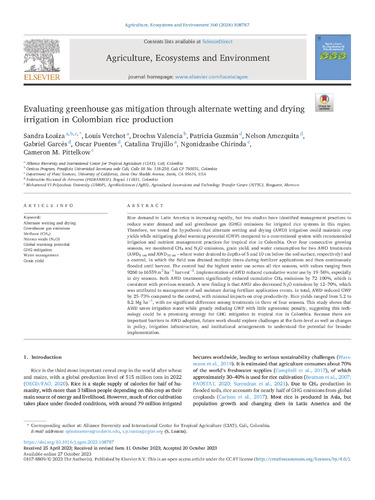Evaluating greenhouse gas mitigation through alternate wetting and drying irrigation in Colombian rice production
Rice demand in Latin America is increasing rapidly, but few studies have identified management practices to reduce water demand and soil greenhouse gas (GHG) emissions for irrigated rice systems in this region. Therefore, we tested the hypothesis that alternate wetting and drying (AWD) irrigation could maintain crop yields while mitigating global warming potential (GWP) compared to a conventional system with recommended irrigation and nutrient management practices for tropical rice in Colombia. Over four consecutive growing seasons, we monitored CH4 and N2O emissions, grain yield, and water consumption for two AWD treatments (AWD5 cm and AWD10 cm - where water drained to depths of 5 and 10 cm below the soil surface, respectively) and a control, in which the field was drained multiple times during fertilizer applications and then continuously flooded until harvest. The control had the highest water use across all rice seasons, with values ranging from 9260 to 16559 m3 ha−1 harvest−1. Implementation of AWD reduced cumulative water use by 19–56%, especially in dry seasons. Both AWD treatments significantly reduced cumulative CH4 emissions by 72–100%, which is consistent with previous research. A new finding is that AWD also decreased N2O emissions by 12–70%, which was attributed to management of soil moisture during fertilizer application events. In total, AWD reduced GWP by 25–73% compared to the control, with minimal impacts on crop productivity. Rice yields ranged from 5.2 to 8.2 Mg ha−1, with no significant difference among treatments in three of four seasons. This study shows that AWD saves irrigation water while greatly reducing GWP with little agronomic penalty, suggesting this technology could be a promising strategy for GHG mitigation in tropical rice in Colombia. Because there are important barriers to AWD adoption, future work should explore challenges at the farm-level as well as changes in policy, irrigation infrastructure, and institutional arrangements to understand the potential for broader implementation.

